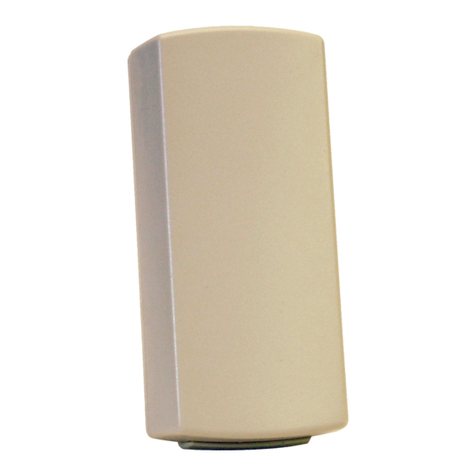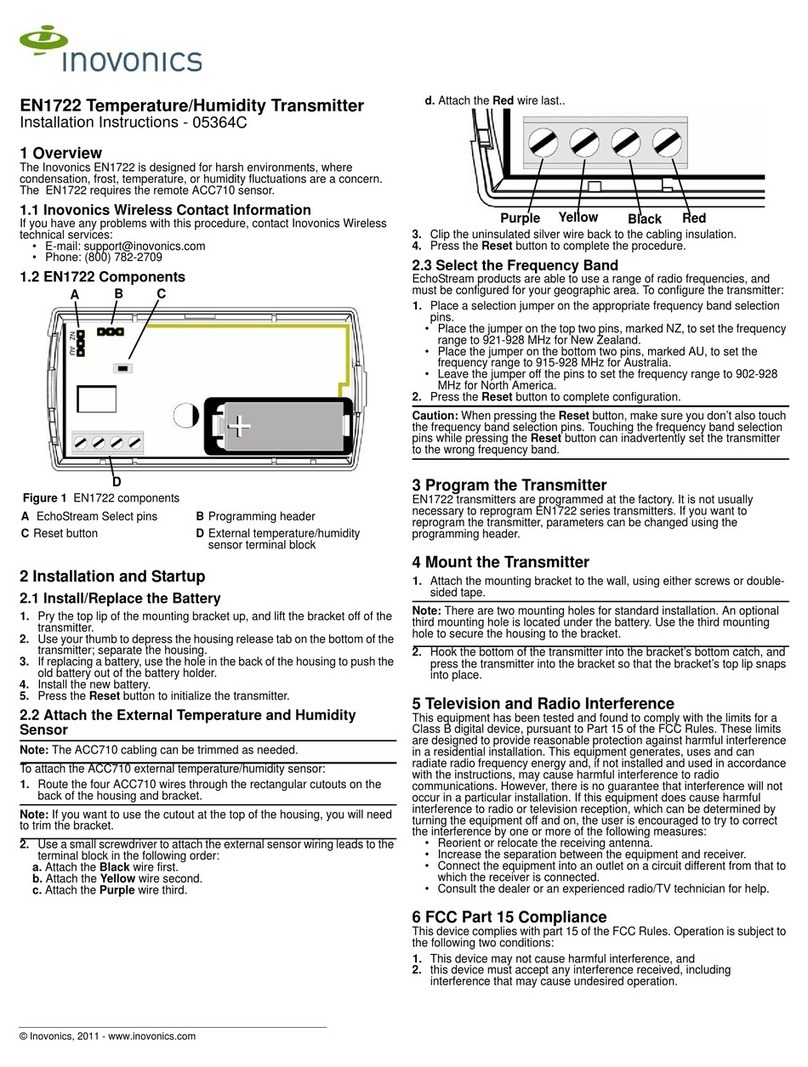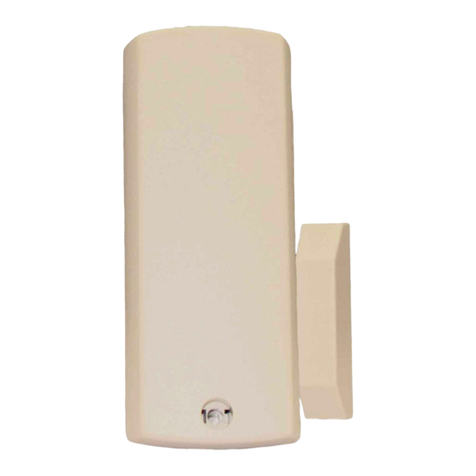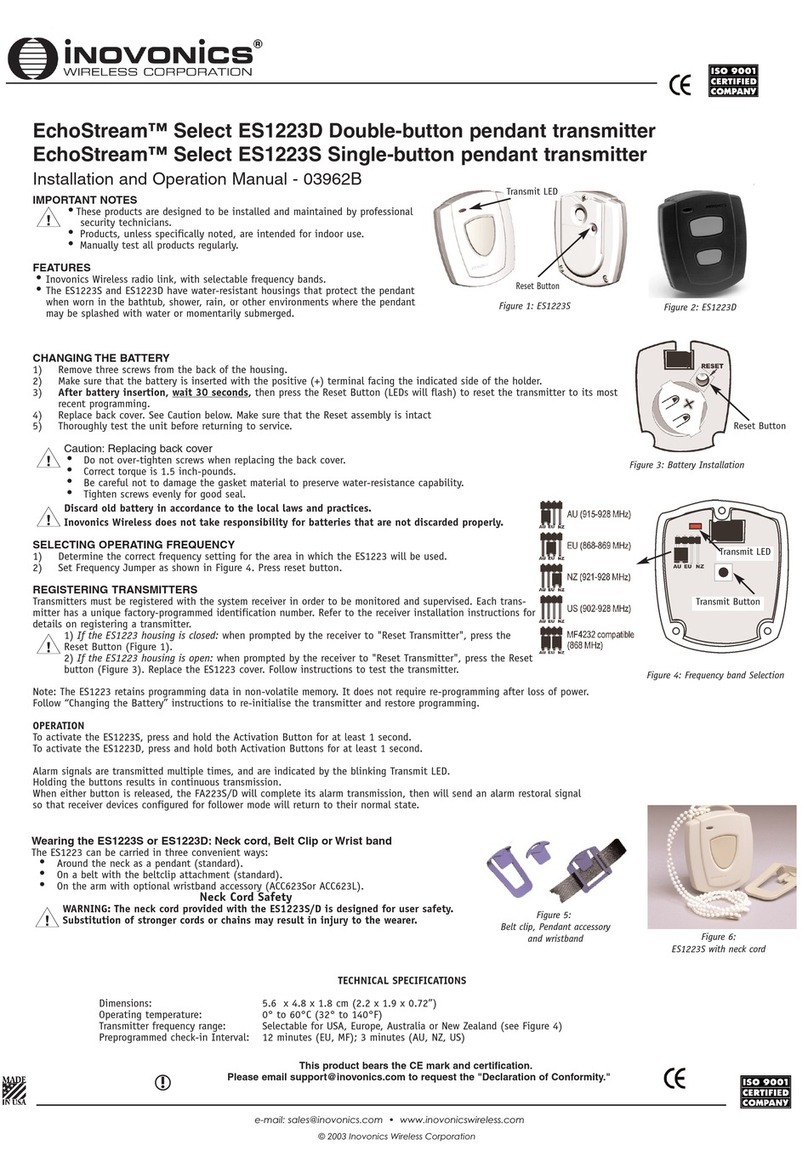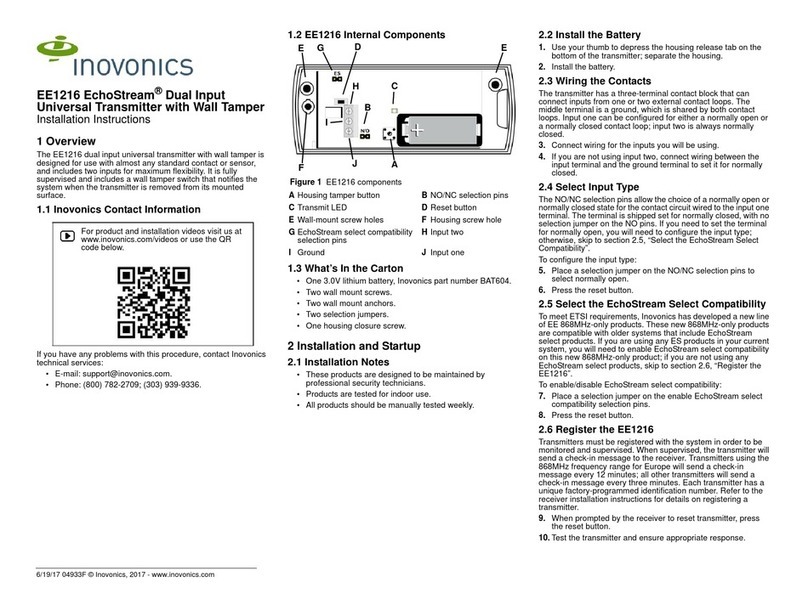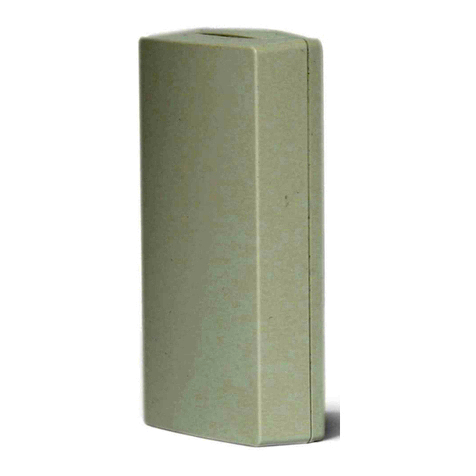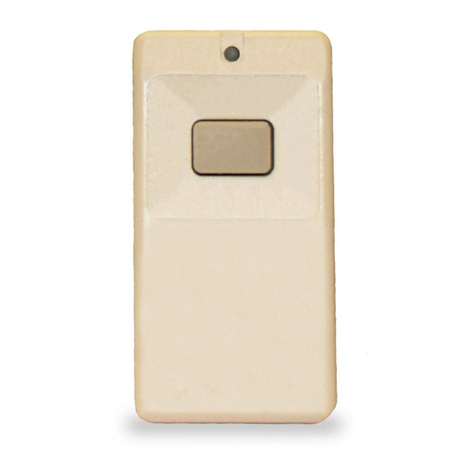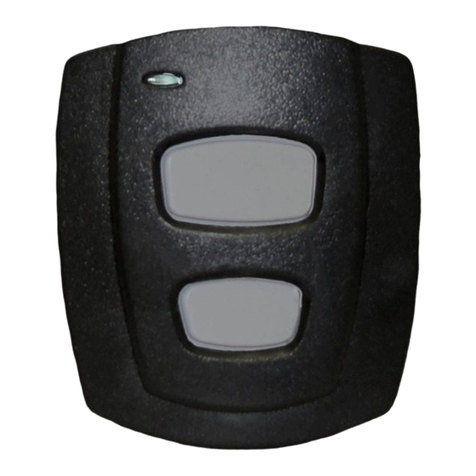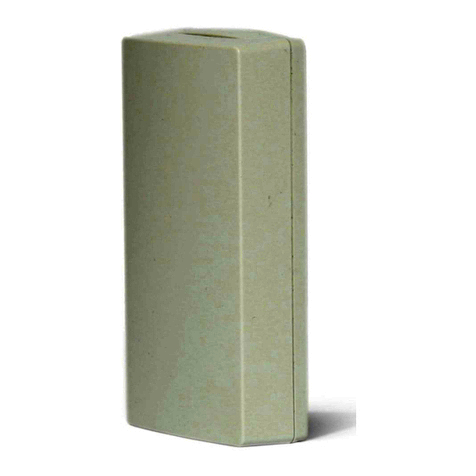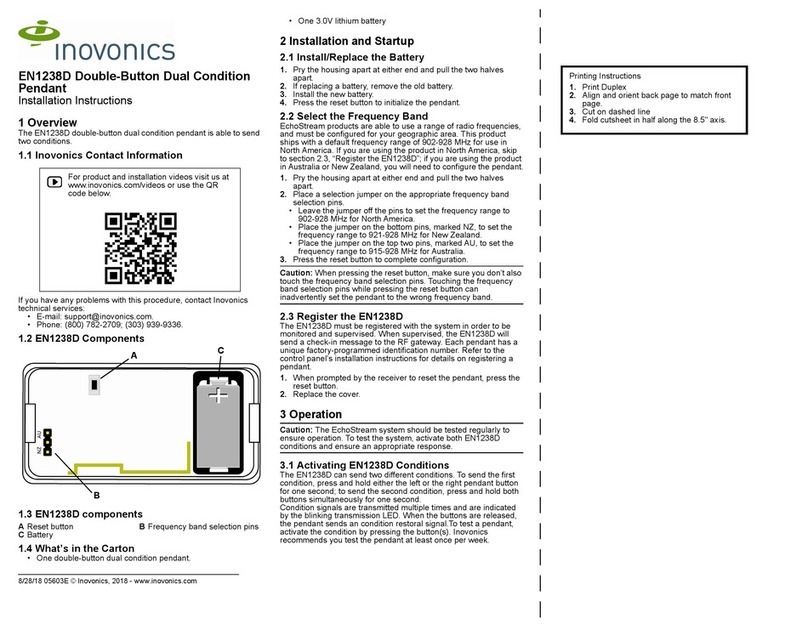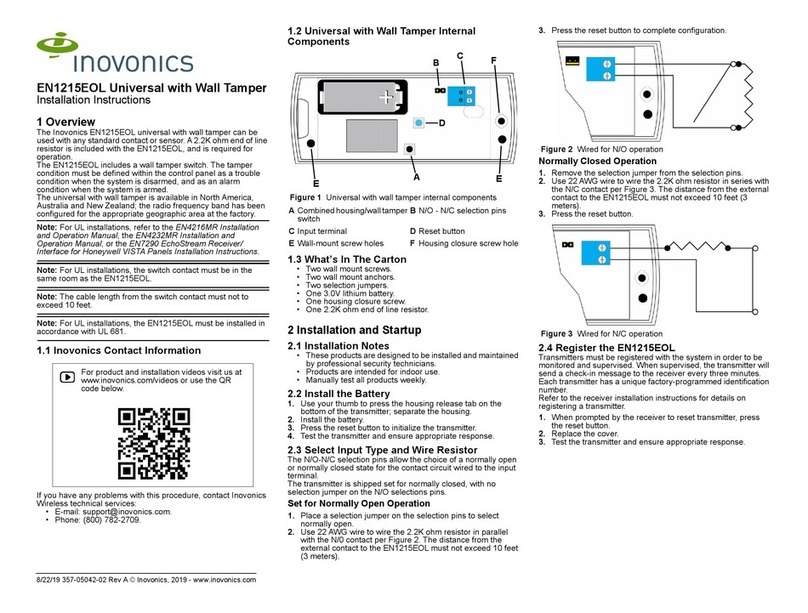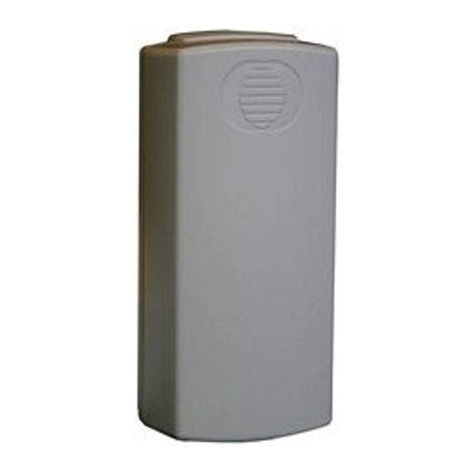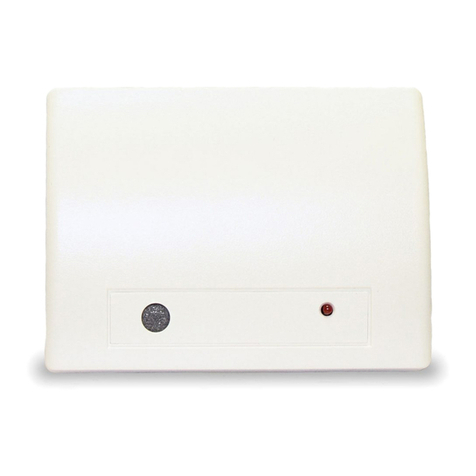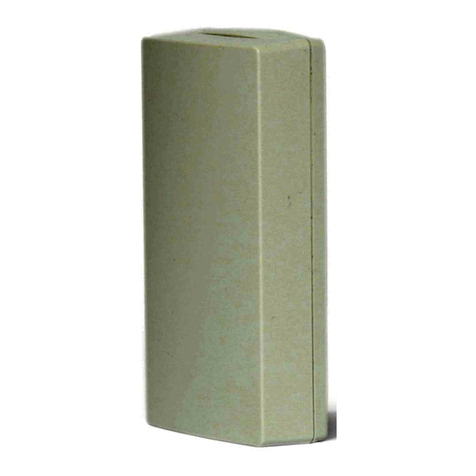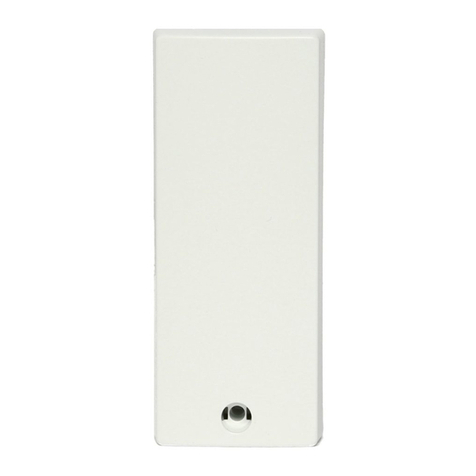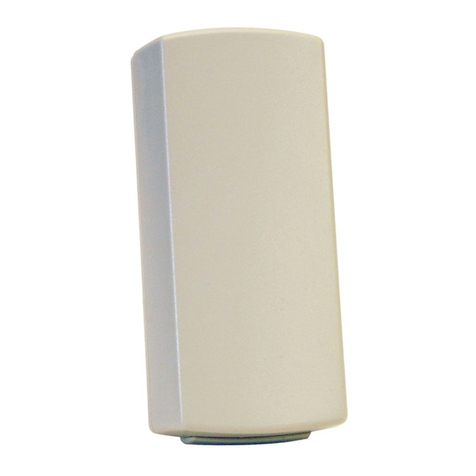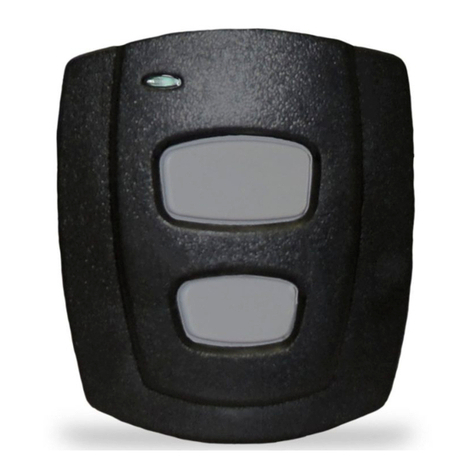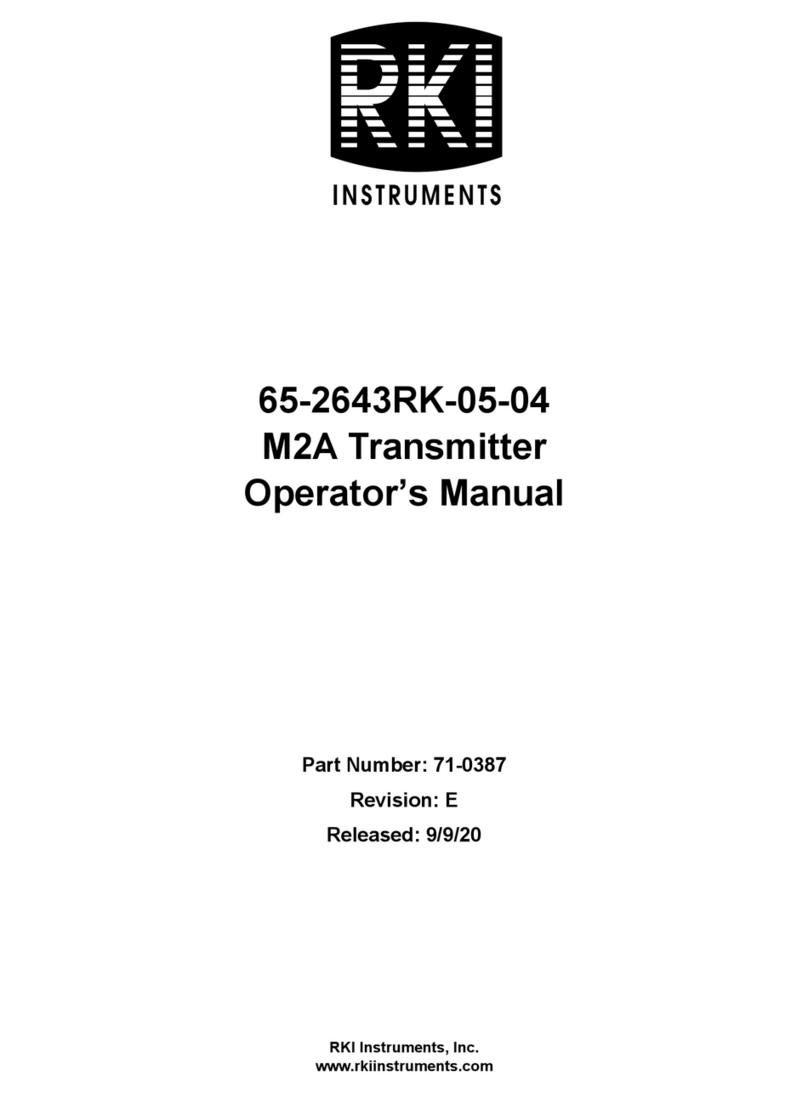
1/24/14 06573A © Inovonics, 2014 - www.inovonics.com 2
3.2 Water Exposure
All EchoStream water-resistant pendants meet IP54 certification standards for dust
and water ingress protection, ensuring that:
• Ingress of dust particles does not interfere with the satisfactory operation of the
device
• There is no harmful effect to the device caused by:
- Vertically dripping water (when device is tilted up to 15° from normal position)
- Spraying water (falling at angles up to 60° from vertical)
- Splashing water (from any direction)
End User Recommendations
The pendant transmitter is water-resistant, but not waterproof. The product is not
designed for submersion in water. As such, we offer the following recommendations to
the end user:
3.3 Battery Replacement
The transmit LED on the EN1223S-15 pendant transmitter will flash every 10 seconds
as long as the battery is operational. If the transmit LED ceases to flash, the battery is
in need of replacement.
Replacement batteries can be purchased from Inovonics using the following part
numbers
• BAT609 for a single battery
• BAT609-25 for a 25-count bulk pack
To replace the batteries:
1. Remove the three housing screws on the back of the transmitter.
2. Remove the rear cover to expose the side of the board which holds the battery.
Caution: Carefully separate the rear housing cover, ensuring the reset button plunger
assembly does not fall out of the housing (Figure 2).
3. Remove the depleted battery.
4. Slide the new battery under the battery holder, ensuring that it is fully inserted and
that the positive terminal (+) faces up (Figure 2).
5. Replace the rear housing cover.
6. Replace the three housing screws, tightening them to 1.25 inch-pounds torque.
7. Once the unit has been sealed, press the reset button located on the rear housing
to complete the configuration (Figure 1).
Note: If you do not have a torque driver, tighten to a snug fit, being careful not to strip
the housing.
Note: Tighten the housing screws evenly to help ensure a good seal and maintain
water-resistance.
Caution: Over-tightening the housing screws can result in microcracks in the plastic,
gaps in the gasket material, and/or stripping of the bushing. Any of these conditions
can compromise the water-resistance of the device.
4 Test the Transmitter
The transmitter should be tested weekly and after registration to ensure operation.
To test the transmitter:
1. Press the activation button for at least one second and ensure the transmit LED
lights and the alarm is received by the receiver or gateway.
2. Press the reset button and ensure the transmit LED lights.
5 US Patent Numbers
•7,154,866
•7,554,932
•7,746,804
6 Specifications
Dimensions: 5.6 x 4.8 x 1.8 cm (2.2 x 1.9 0.72”)
Operating temperature: 0 to 60°C (32 to 140°F)
Operating environment: Water-resistant, non-submersible
Typical battery life: 1-2 years
Battery type: Panasonic CR2450
Power requirement: 3 VDC, 60 mA
Note: Specifications and data are subject to change without notice.
7 Television and Radio Interference
This equipment has been tested and found to comply with the limits for a Class B
digital device, pursuant to Part 15 of the FCC Rules. These limits are designed to
provide reasonable protection against harmful interference in a residential installation.
This equipment generates, uses and can radiate radio frequency energy and, if not
installed and used in accordance with the instructions, may cause harmful
interference to radio communications. However, there is no guarantee that
interference will not occur in a particular installation. If this equipment does cause
harmful interference to radio or television reception, which can be determined by
turning the equipment off and on, the user is encouraged to try to correct the
interference by one or more of the following measures:
• Reorient or relocate the receiving antenna.
• Increase the separation between the equipment and receiver.
• Connect the equipment into an outlet on a circuit different from that to which the
receiver is connected.
• Consult the dealer or an experienced radio/TV technician for help.
8 FCC Part 15 and Industry Canada Compliance
This device complies with part 15 of the FCC Rules and Industry Canada license-
exempt RSS standard(s). Operation is subject to the following two conditions: (1) this
device may not cause interference, and (2) this device must accept any interference,
including interference that may cause undesired operation of the device. Changes or
modifications not expressly approved by the party responsible for compliance could
void the user's authority to operate the equipment.
Le présent appareil est conforme aux CNR d'Industrie Canada applicables aux
appareils radio exempts de licence. L'exploitation est autorisée aux deux conditions
suivantes : (1) l'appareil ne doit pas produire de brouillage, et (2) l'utilisateur de
l'appareil doit accepter tout brouillage radioélectrique subi, même si le brouillage est
susceptible d'en compromettre le fonctionnement.
9 Warranty and Disclaimer
Inovonics Wireless Corporation ("Inovonics") warrants its products ("Product" or
"Products") to conform to its own specifications and to be free of defects in materials
and workmanship under normal use for a periodof thirty-six (36) months from the date
of manufacture. Within the warranty period, Inovonics will repair or replace, at its
option, all or any part of the warranted Product. Inovonics will not be responsible for
dismantling and/or reinstallation charges. To exercise the warranty, the User ("User",
"Installer" or "Consumer") must work directly through their authorized distributor who
will be given a Return Material Authorization ("RMA") number by Inovonics. Details of
shipment will be arranged directly through the authorized distributor.
This warranty is void in cases of improper installation, misuse, failure to follow
installation and operating instructions, alteration, accident or tampering, and repair by
anyone other than Inovonics.
This warranty is exclusive and expressly in lieu of all other warranties, obligations or
liabilities, whether written, oral, express, or implied. There is no warranty by Inovonics
that Inovonics product will be merchantable or fit for any particular purpose, nor is
there any other warranty, expressed or implied, except as such is expressly set forth
herein. In no event shall Inovonics be liable for an incidental, consequential, indirect,
special, or exemplary damages, including but not limited to loss of profit, revenue, or
contract, loss of use, cost of down time, or interruption of business, nor any claim
made by distributor's customers or any other person or entity.
This warranty will not be modified or extended. Inovonics does not authorize any
person to act on its behalf to modify or extend this warranty.
This warranty will apply only to Inovonics Products. Inovonics will not be liable for any
direct, incidental, or consequential damage or loss whatsoever, caused by the
malfunction of Product due to products, accessories, or attachments of other
manufacturers, including batteries, used in conjunction with Inovonics Products.
Usage Situation OK to Use? Cautions
Shower Yes Do not spray water directly on the
device at distances of less than 12
inches;avoidsprayingwaterathigh
pressure
Bath Yes Do not submerge the device
Rain Yes Avoid extended exposure; wear the
device under a sleeve, shirt, or
jacket
Water Exercise No Do not use the device during these
activities
